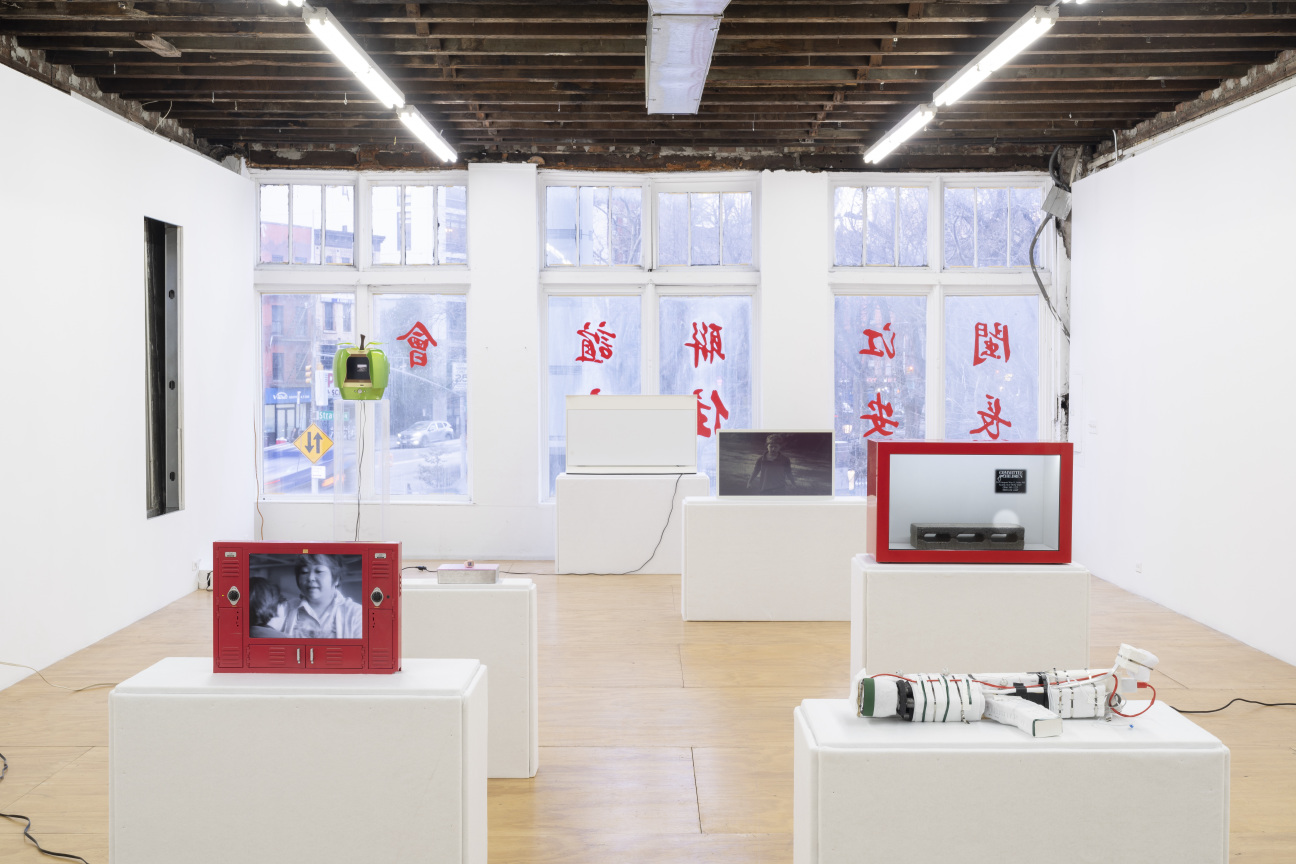
Marc Kokopeli
Reena Spaulings Fine Art | 165 East Broadway
On view through March 8, 2025
A pale pink ring with a minuscule screen playing the entire first season of Paris Hilton and Nicole Richie’s The Simple Life; a plastic, double-doored, glistening green apple with another screen inside; two egg-shaped, cherry-red Memorex MSP-TV1300s with gleaming visors reminiscent of astronauts’ helmets; a tiny television embedded inside a row of red lockers embossed with golden letters reading “High School Musical”—this is an incomplete list of the hardware featured in Marc Kokopeli’s exhibition “MY TV SHOW I ❤️ TV,” currently on view at Reena Spaulings Fine Art.
Stories of negligent fathers, lunchtime brawls, hesitant Little Leaguers, and molested children play out on the New York-based artist’s armada of screens. While most of this material was produced in the ’90s by an entity called the Committee for Children, the televisions themselves present a temporal disjunction: the Memorex sets were manufactured in 2002, and several others—which look like cavernous microwaves—were sourced more recently from Alibaba.
One of the show’s strongest works is an outlier among the videos. And it’s one of the only objects that Kokopeli constructed himself. The sculptural firearm Bazooka, 2024, contains a smartphone hooked up to a motion-sensing home security camera that “shoots” visitors when they pass by. As you watch the videos in the gallery, this work watches you. Wrapped in stapled, synthetic white fabric strips, the gun’s wondrously imperfect form recalls Kokopeli’s previous solo show at the gallery, “die Pampertaarten,” in 2022, which consisted of a fleet of “diaper cakes” made to resemble motorcycles, ATVs, and tanks.
Code Red, 2024, is the most successful iteration of Kokopelli’s sourced style: miniature projections of the Committee for Children films appear on the glass face of one of the microwave-like structures alongside a roving white circle that evokes a sniper’s crosshairs. Behind the glass sits a cinderblock, a hard-edged readymade that threatens the soft-edged videos playing on the work’s fragile surface. The successful interplay between Code Red and Bazooka made me wish that Kokopeli had pared “MY TV SHOW” down a bit. But even though the exhibition isn’t as cohesive as his last one here was, its individual components are no less evocative. They are likewise fraught with childhood memory that spills into the present. —Will Harrison
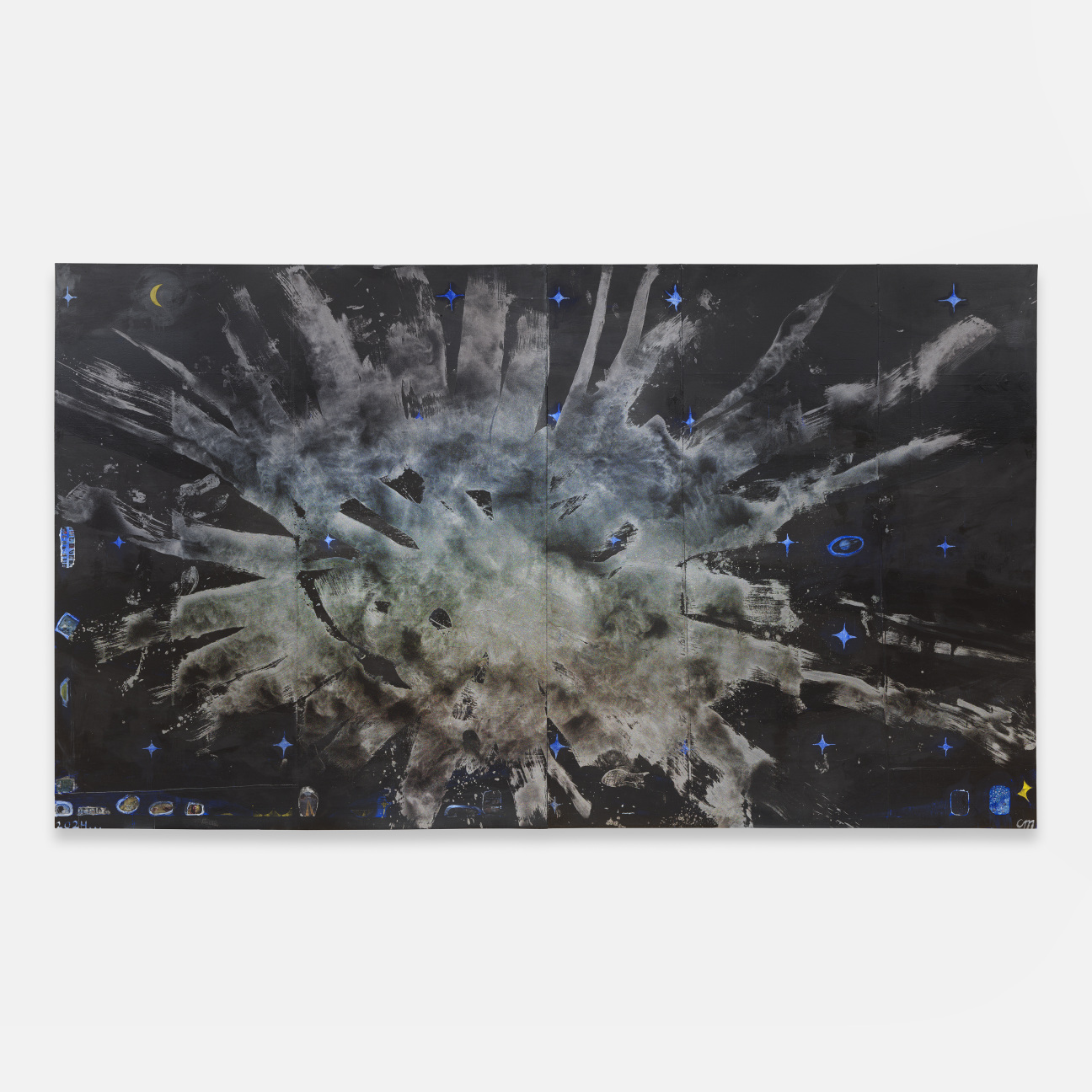
Chris Martin
Timothy Taylor | 74 Leonard Street
On view through February 22, 2025
Imagine a version of this review as a Socratic dialogue between two critics, one arguing for and one against Chris Martin’s often glitter-encrusted paintings now on view at Timothy Taylor gallery. Rational arguments could be made against the six paintings here, arriving at negative conclusions to fundamental questions: Are the paintings good? Do they succeed? Each time I've seen a show by this quintessential New York painter, who splits his time between the Catskills and Brooklyn, I've staged this debate in my mind. But the killjoy critic has never won yet.
There's the massive scale; the collaged bits of print imagery (planets, stars, music ephemera, animals, mushrooms—why make what you can borrow with scissors and glue?); the bold, often primary colors; indelicate brushwork galore; and the simple, if irregular patterns and geometries. Beyond glitter, the surfaces are sometimes embedded with sequins, as in Staring Into The Sun 748 Russell Hill Road, 2024, where, among the immense, wobbly lateral stripes in Rastafarian red, green, and yellow, these metallic flecks can be seen in the shape of snowflakes, a maple leaf, and so on. In this and half of the other paintings here, a starburst dominates the center of the composition and radiates outward.
Martin's bedazzled AbEx stylings, will have a good time with or without you. They are cousins to Katherine Bernhardt’s ebullient, slapdash Pink Panther paintings in this way. A room full of Martin’s canvases has never failed to lift my mood. However, the debate between the warring critics in my mind is real. The skeptic in me is won over by Speed of Light, 2024, which may be the best Martin painting I've ever seen, with its supernova of iridescent glitter exploding across the canvas's approximately 10 by 20-foot black expanse. In the backroom, Burst, 2024-25, achieves a similar effect on a smaller scale, while incorporating what look like cut-up bits of a sequined dress. But even the fan in me sees the shortcomings on display in Dark Matter, 2024.
Upon entering the gallery, this painting’s posterior—its more interesting side—greets you. On the back you see collaged bits of more solar systems alongside a Best of Donna Summer track list, a photo of a buffalo on an icy prairie, an obituary of the painter Al Held, and—most interestingly—photographs of more successful, earlier iterations of this very painting. On the front is a painting that’s been reworked and revised nearly to death, leaving a black field, some traces of muddied glitter, and polka dot “stars” mostly evenly distributed across its surface, except near the top, where maybe it was hard to reach?
This is the first time I’ve seen a show by the artist where one painting stood out clearly as a flop. And yet—perhaps heightened in contrast—the rest of the paintings here are great. The killjoy, once again, admits defeat. —John Vincler
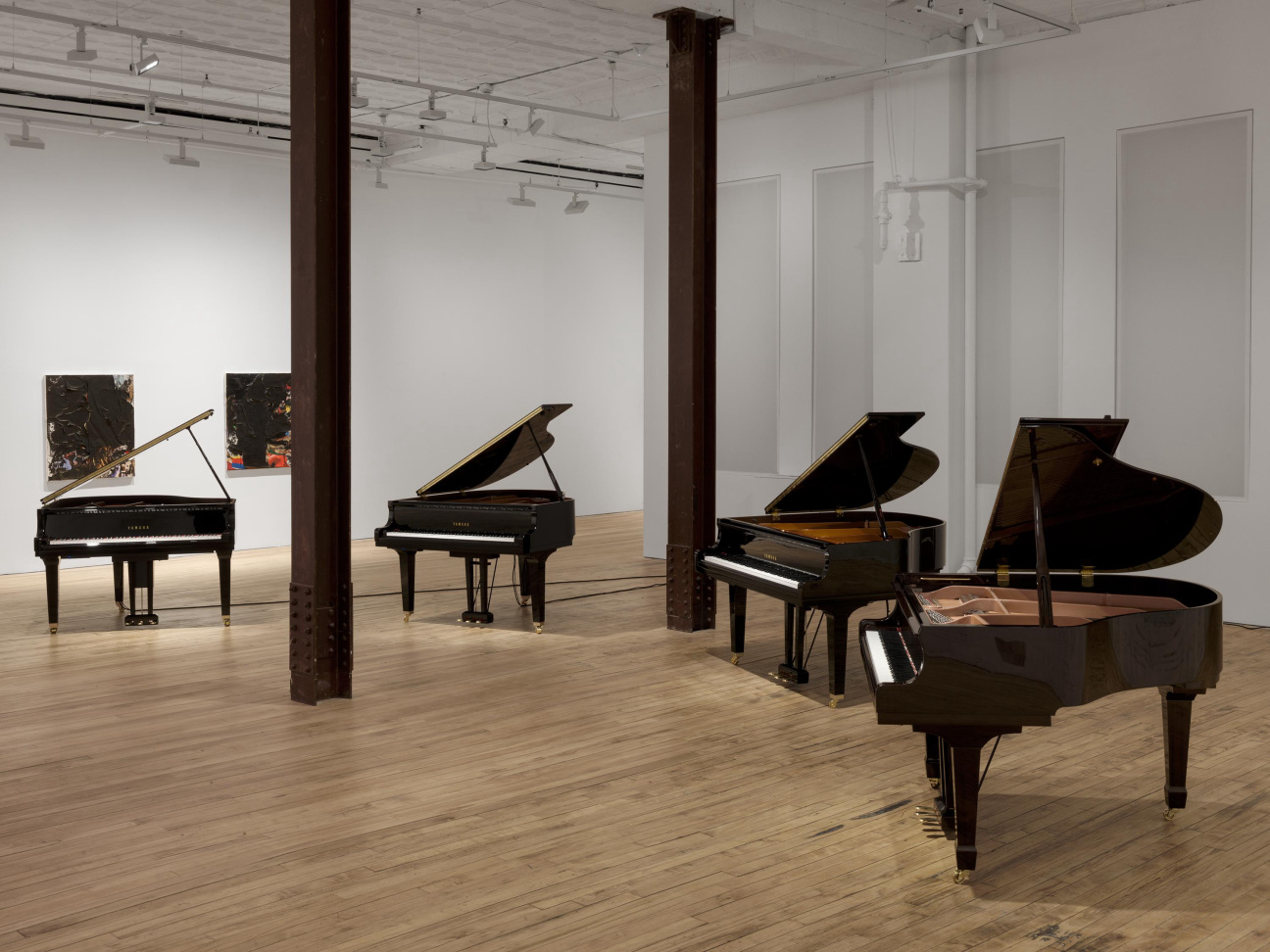
Julius Eastman & Glenn Ligon
52 Walker | 52 Walker Street
On view through March 22, 2025
Arrive on the hour, and you'll hear the transfixing, somber post-minimalist score from which the exhibition borrows its title. Beginning with a single pulsing note, building into simple repeated motifs, and eventually cascading into moving variations, the music emanates from three self-playing Yamaha Disklavier pianos. A fourth piano, a Weber, remains silent. This model was the composer Julius Eastman’s lifelong instrument of choice.
The minimalism of Philip Glass and Steve Reich comes immediately to mind. And, like these composers, Eastman (1940–1990) oscillated between New York’s Uptown and Downtown scenes. As a vocalist, pianist, and composer, he collaborated with Meredith Monk, Arthur Russell, and many others.
About the exhibition title—a note from the curator requests that "the title of the exhibition…not be censored or altered." And if it is: "It is requested that the publication note that this change is at the discretion of the publication." The show's title "Evil N—–" will not appear in full as typed from my keyboard, just as I wouldn't say the title aloud. And in making this choice, I’m outing myself as a white critic. (That I have never before had to identify myself, as such, may well be part of the point.) As I stood in the gallery enthralled by the composition playing before me, I wondered if I was unfamiliar with Eastman’s oeuvre because he was a Black composer. When I searched my mind for connections between Blackness and minimalist music, I remembered only that Reich’s seminal work, Come Out, from 1966, hinges on a looped bit of tape of 18-year-old Daniel Hamm, a young Black man, recounting his brutal beating at the hands of New York police in Harlem’s 32nd precinct.
The greatest American contribution to the history of music is Jazz. And Jazz appears here as a silent specter. To the right of the quartet of pianos—near Glenn Ligon’s work Untitled (negro sunshine), 2005, which shows its title’s parenthetical glowing in neon—a series of prints reproduces manuscript sheets from Eastman’s composition, Thruway, 1970. The first framed page provides a prompt rather than a notated score: "The players must play only the essence of Jazz. Not popular tunes… but jagged and improvisatory in nature.”
Early in the 1980s, when Eastman was evicted from his New York apartment, he lost his archive and most of his belongings. Despite this, even while living on the streets, he retained a photocopy of the Thruway score. Curator Ebony L. Haynes’s choice to display the surviving document prominently in reproduction as a work of art connects to several recent or current shows in New York that present archival material to elucidate the practices of legendary Black artists and thinkers: the recently closed Alvin Ailey show at the Whitney Museum, the current Belle Greene exhibition at The Morgan Library & Museum, and American Artist’s recently-opened show at Pioneer Works, which incorporates files from Octavia E. Butler’s papers, housed at the Huntington Library near Los Angeles.
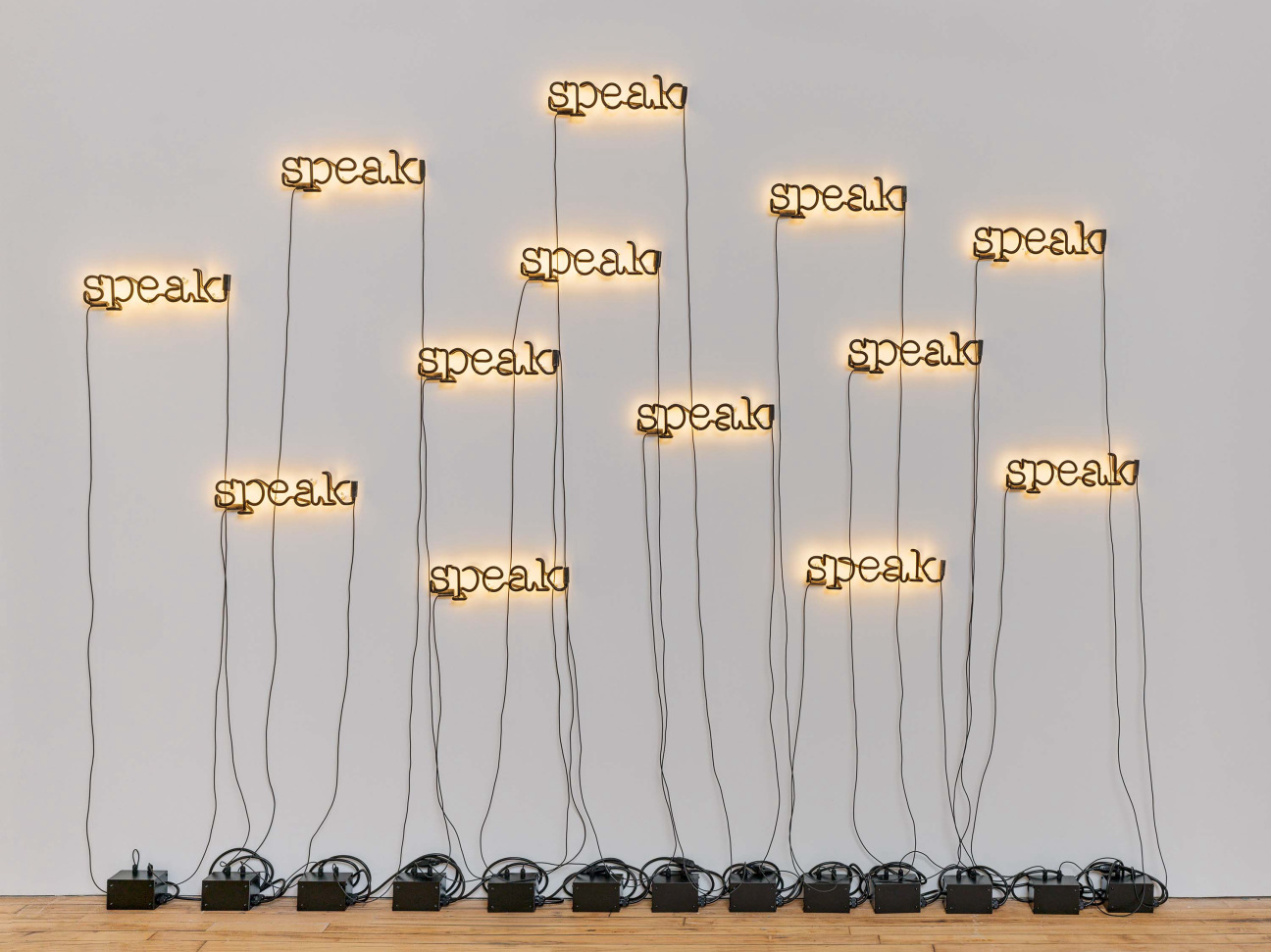
In these other shows, the Black archive takes up space, representing the depth and breadth of achievement. But here, the trace fragments are cryptic and incomplete, gesturing at what was lost or what could have been. In this way, they recall Saidiya Hartman’s concept of critical fabulation—the proposition that the lives and works of those who have been omitted from the archive must be speculatively reimagined through willful acts of recovery and research-informed invention. The whole of the exhibition at 52 Walker becomes a theater for this—in reading Thruway’s score, you can try to imagine hearing it.
When I arrived to see the exhibition, I thought I was going to see the latest Glenn Ligon show, but the visual artist’s work plays a supporting role here, helping us to see the genius of Eastman. Ligon maps an artistic cosmology, with works like the James Baldwin-inspired oil-stick and coal-dust painting, Stranger #98, 2023, and Untitled (America) (for Toni Morrison), 2024, which reproduces and repeats, in neon, the onomatopoeic “Sth.” The first word in Morrison’s novel Jazz is really a sound—of air sucked in sharply through teeth, punctuating a moment with any number of possible, context-specific meanings. Here, Eastman is placed in a Black pantheon of figures from art and literature, and—through an act of deft and inventively bold curatorial imagining—is restored to rightful prominence. —John Vincler
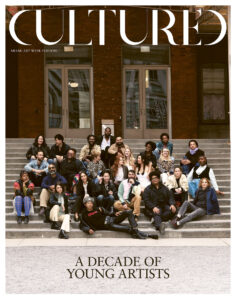
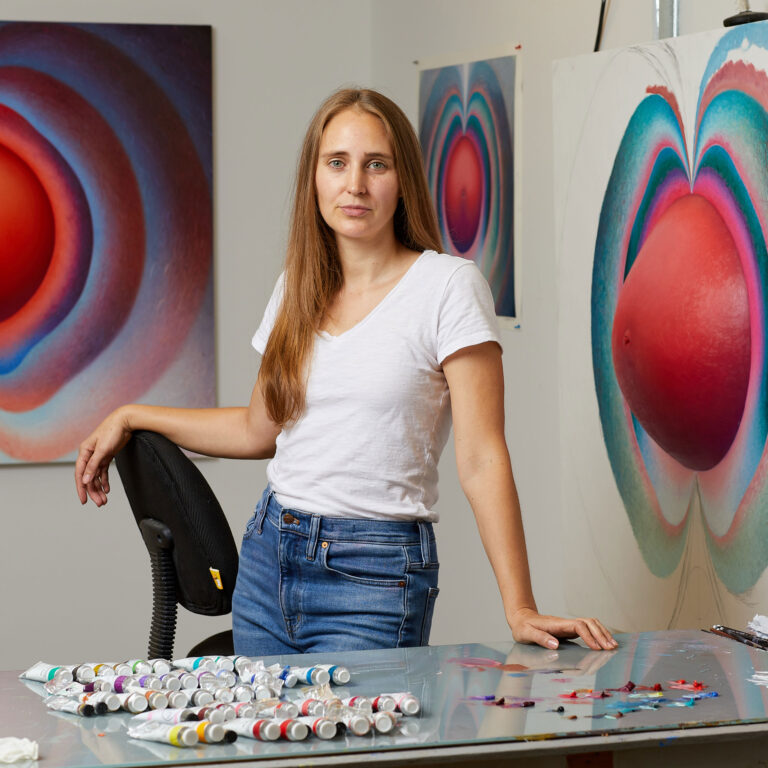






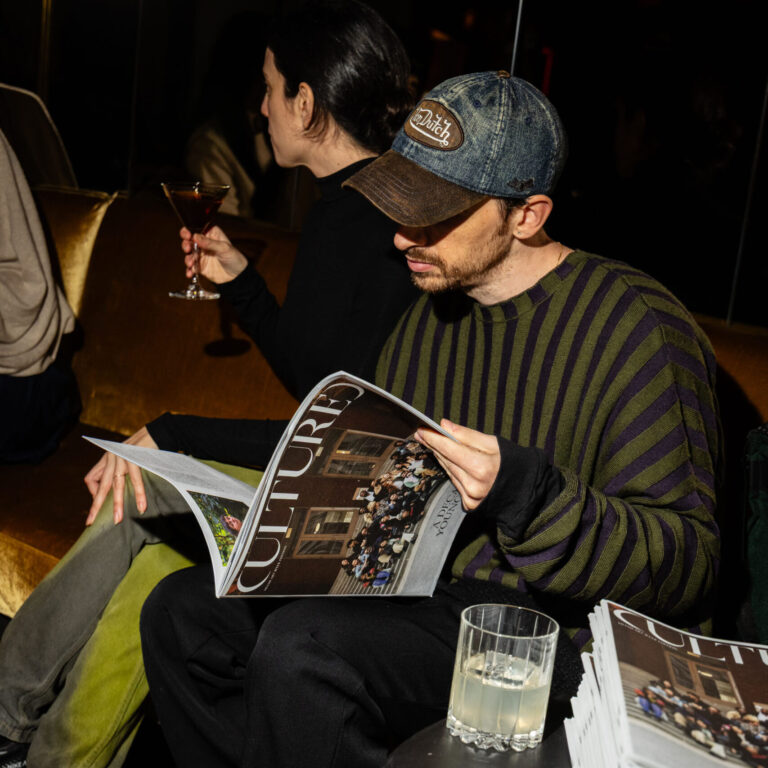

 in your life?
in your life?

